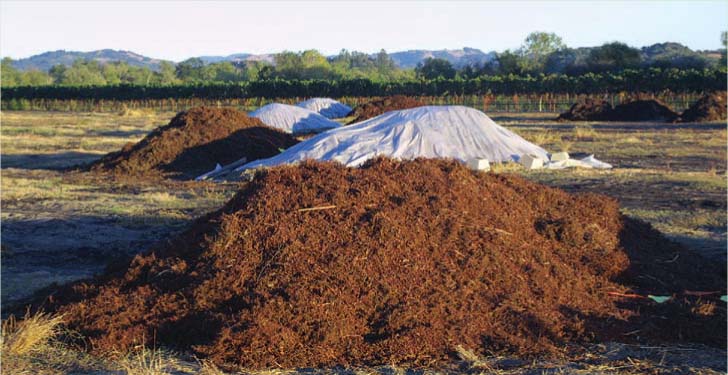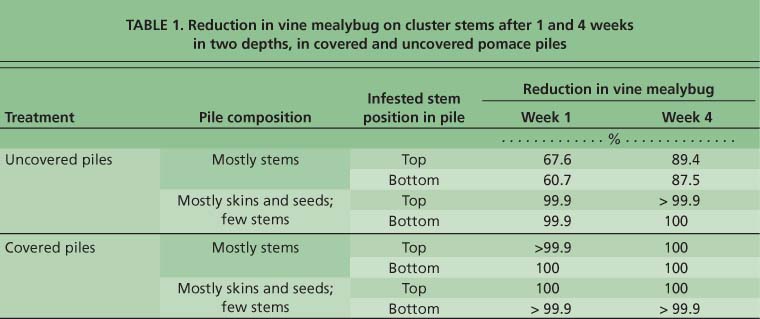All Issues
Sidebar: Pomace management reduces spread of vine mealybugs
Publication Information
California Agriculture 62(4):172-173. https://doi.org/10.3733/ca.v062n04p172
Published October 01, 2008
PDF | Citation | Permissions
Full text
After vine mealybug was first identified in North Coast wine-grape vineyards in 2002, growers and wineries needed answers to reduce the movement of this pest between vineyards. We investigated the potential for vine mealybugs to survive in one type of winery waste (or pomace) that is often spread over the vineyard floor during the harvest period.
The pomace we investigated contains unfermented berry skins, seeds and cluster stems. This fresh material is produced by pressing hand-harvested whole clusters or mechanically harvested berries; the juice is then fermented. Alternatively, clusters are processed by a destemmer-crusher, after which skins and seeds are fermented with the juice, producing sediment also known as pomace. Because insects do not survive the fermentation process, we focused on the survival of vine mealybug in fresh pomace collected from the winery press after whole clusters were pressed, as well as in piles of fresh pomace placed on the vineyard property.
Mealybug survival after whole-cluster press.
Two trials were conducted in wineries located in Sonoma County to determine if vine mealybug survived whole-cluster pressing. In the first trial, a 6-ton load of infested ‘Grenache’ grapes underwent a press regime ranging from 0.2 to 1.8 bars of pressure. Before pressing, we found an average of 47 live vine mealybugs per cluster. After the press was completed, there were an average of 0.04 live vine mealybugs per cluster (0.085% survival). In the second trial, single infested clusters were placed inside mesh bags and added to a 12-ton load of ‘Chardonnay’ grapes that underwent a similar press regime. Before pressing, we found an average of over 4,800 vine mealybug crawlers (the small immature stage) per cluster. Afterward, this dropped to an average of 192 crawlers per cluster (4.0% survival).
These trials showed that vine mealybugs can survive whole-cluster pressing. As a result, fresh pomace can be a source of vine mealybug contamination for wineries or growers who traditionally spread this harvest residue directly in the vineyard or who stockpile unmanaged piles of it near the vineyard.
Pomace piles were covered with clear plastic or remained uncovered to evaluate vine mealybug survival.
Controlling mealybugs in pomace.
Another experiment evaluated vine mealybug mortality in static pomace piles that were either uncovered or covered with clear plastic. Infested cluster stems were placed inside mesh bags that were then inserted 1-foot (0.3 meter) and 3-feet (0.9 meter) deep into pomace piles that were 4 feet (1.2 meters) tall and 15 feet (4.5 meters) across, approximately the size of piles created by dump trucks commonly used by wineries. Initially, the clusters had an average of 1,211 live vine mealybugs per stem.
Results showed that vine mealybug mortality was higher when pomace piles were covered for 1 to 4 weeks with clear plastic than when piles were left uncovered (table 1). When uncovered, more vine mealybugs survived in piles consisting of mostly stems discarded from the destemming process than in the denser, moister piles composed primarily of berry skins and seeds from the whole-cluster press. Uncovered piles composed primarily of stems had greater survival of vine mealybug over time because these piles did not generate high enough temperatures to kill vine mealybugs.
In contrast, when pomace piles were covered, vine mealybugs were reduced by nearly 100% in both “stemmy” and nonstemmy piles. In addition, when covered there was no difference in mortality at different depths in either type of pile. Fresh pomace piles generate heat as organic material degrades. Temperature loggers recorded significantly lower fluctuation at higher temperatures of 120°F to 130°F (50°C to 55°C) in pomace piles with fewer stems and more moisture, than at temperatures of 68°F to 130°F (20°C to 55°C) in piles with a greater mass of cluster stems, which are slower to break down (data not shown).
TABLE 1 Reduction in vine mealybug on cluster stems after 1 and 4 weeks in two depths, in covered and uncovered pomace piles
Recommendations.
To reduce the risk of contaminating vineyards with mealybugs, growers should avoid spreading pomace in vineyards unless it has been covered with plastic for at least 1 week. Optimally, pomace piles should be located away from vine rows and securely covered as soon as feasible, so heat that is generated remains inside the pile. To help increase temperatures inside stemmy piles and decrease vine mealybug survival, cluster stems collected from a winery's destemmer should be mixed with dense material, such as pomace from either whole-cluster or mechanically harvested press loads. Frontend loaders, which are commonly used in many wineries, may be used to mix pomace piles to some degree.
We did not evaluate the survival of vine mealybug in composted pomace. At facilities required to obtain a Compostable Materials Handling Facility Permit from the California Integrated Waste Management Board, regulations require that the windrow composting process under aerobic conditions maintain a temperature of 13°F (55°C) or higher for 15 days or longer to reduce pathogens. During that period, the windrow must be turned a minimum of five times. Given these rigorous requirements, this process is likely to result in similar or increased mortality of vine mealybugs compared to static, covered pomace piles.
Sanitation practices are recommended to avoid spreading any species of mealybug. Many wineries, regardless of size, find it challenging to cover pomace with clear plastic as it is generated. During the harvest period, pomace may be produced daily at a rate of approximately a ton of pomace for every 3 to 6 tons of grapes, so the lack of space to store and manage this material away from grapevines is a critical problem. Bins and dump trucks that are used to move pomace during the production process may potentially contaminate subsequent loads of fresh grapes with mealybugs. Containers used to haul grapes and pomace should be cleaned with a high-pressure sprayer before they are moved offsite.






